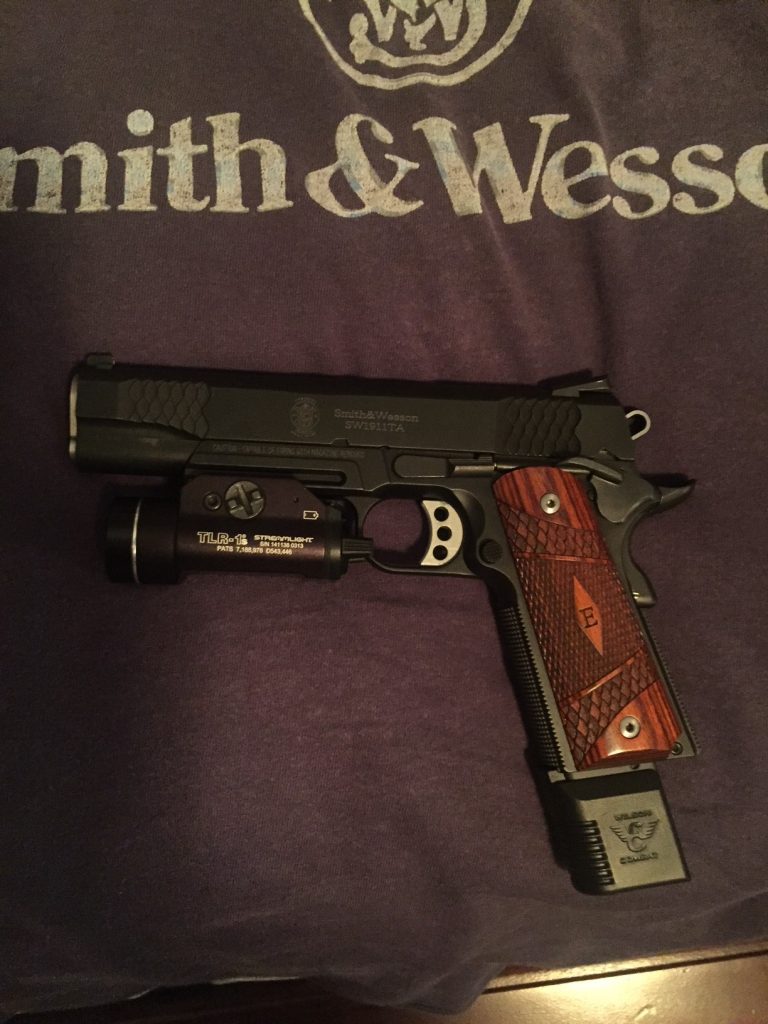The Effect Of Pistol Barrel Length On Shooting
BY Herschel SmithShooting Sports USA has an interesting article on changing barrel lengths and the necessary adjustments to everything else. I confess I had never thought of most of that. There is this interesting deliverance of their testing.
Accuracy testing with a six-inch barrel resulted in an approximate 30 FPS drop in velocity when the same barrel was shortened to five inches. Surprising to some, accuracy actually improved by ⅜ inch (.375) with the shorter barrel. This was likely due to a balance of velocity and stabilization.

I’ve got a trip into the bush coming up soon and this is the rig I’m carrying.

I like the 5″ barrel and the weight added by the tactical light and the Wilson Combat magazine. To me it assists in stabilization versus shooting .45 ACP from a 4.25″ barrel (which takes me a little longer to recover sight picture due to muzzle rise).





On June 24, 2018 at 11:58 pm, Georgiaboy61 said:
The “secret sauce” which allowed the 5-inch barrel to shoot better (more-accurately) than the 6-inch barrel was likely the phenomenon of barrel harmonics.
In theory, a longer barrel ought to enhance accuracy, all other variables being equal. The reason why it does not always work out that way has to do with vibration frequency, specifically barrel harmonics when a shot is fired.
High-speed photography shows us that a barrel whips like a strand of just-cooked spaghetti when a shot is fired. The vibration (frequency) of a given barrel can be uncovered by careful empirical testing, or by some mathematical methods as well.
This is the reason reloaders are so diligent in parsing and testing their different charge weights – to see which precise propellant charge fits the harmonics the best, and thereby allows accurate shooting.
Think of the barrel like an ultra-high speed pendulum, vibrating or swinging back and forth through center (the line of the bore).
Charge weights which fire the bullet when the barrel is out-of-alignment with the original bore line-of-sight, tend to produce inaccurate, widely-dispersed groups on the target.
On the other hand, those charges which have the slug leaving the barrel just as it passes through center-of-the-bore, tend to produce the tightest, most-accurate groups on target.
In principle, both your six and five-inch barrels should be “tunable” to fire tight groups, given attention to detail, meticulous loud development, and rigorous testing at the range.
Your loss of ~ 30 fps per inch of barrel lost is consistent with the findings of others in the FA community.
If you are really anal-retentive about this stuff, you could develop a load which tests accurately out of both barrels – the 5-inch and 6-inch – but that’s a lot of trouble, and how much accuracy do you really need?
There is a cost-benefit curve at which additional inputs of energy, study, testing and materials does not yield further gains per your goals. You can go as far with this development process as you like – or not. The choice is entirely yours.
On June 25, 2018 at 12:00 pm, DAN III said:
Mr. Smith,
I own a S&W E Series 1911 myself. I much prefer it over the Kimbers I have. An exquisite 1911 for a reasonable price.
On June 26, 2018 at 2:14 am, Dan said:
The genius John Moses Browning designed the cartridge AND the 5″ 1911.
As one of the premier firearms designers in all of history he KNEW what worked. All changes to his design since then have been compromises. Some of these compromises work better than others but ALL are departures from what was the near perfect design of the original.
On June 26, 2018 at 8:31 pm, JoeFour said:
For all 1911 fans, here’s a link to a Q&A with a true 1911 guru…John Travis of N. Carolina aka 1911Tuner…
https://www.bersachat.com/forums/showthread.php?26088-1911Tuner-FAQ